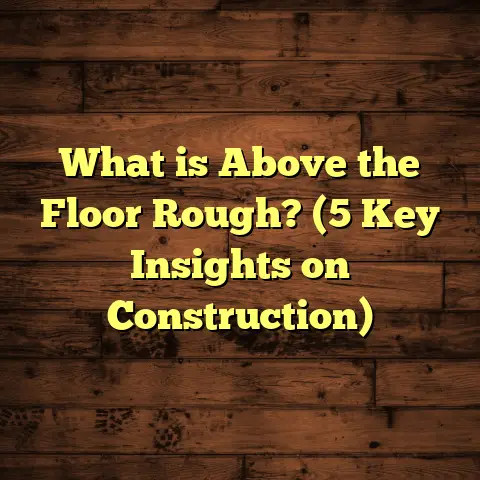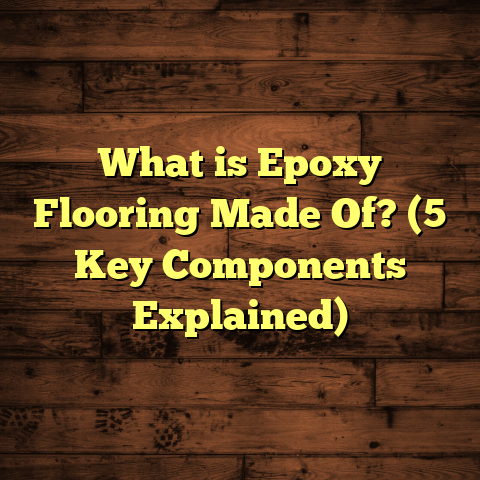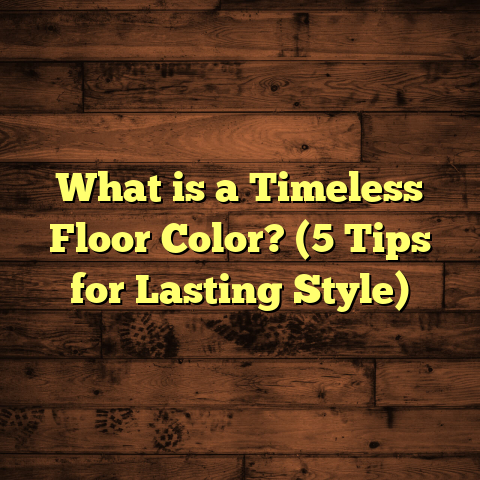What is Vinyl Plank Flooring Cost? (5 Key Factors You Must Know)
When I first started working with vinyl plank flooring, I was all about finding a quick and effective way to upgrade a space without breaking the bank or spending weeks on installation. Vinyl plank flooring quickly became my go-to solution for fast, stylish, and durable flooring. If you’re thinking about giving your floors a facelift but wondering about the cost, I’ve got some real insights to share from my hands-on experience.
What is Vinyl Plank Flooring?
Vinyl plank flooring is a type of resilient flooring designed to mimic the look of natural materials like hardwood or stone. It comes in long, narrow planks that are easy to install and maintain. Unlike traditional hardwood, vinyl planks are made from synthetic materials such as polyvinyl chloride (PVC), which makes them water-resistant and scratch-resistant.
What makes vinyl plank flooring stand out is its versatility. Whether you want a rustic oak look or a sleek modern finish, there’s a vinyl plank style for every taste. The planks can be clicked together for a floating floor or glued down for added durability.
Here’s something I learned early on: vinyl plank flooring isn’t just about appearance – it’s about function. It’s perfect for high-traffic areas, kitchens, bathrooms, and basements because it handles moisture and wear far better than many other flooring options.
If you’ve ever faced the frustration of a warped hardwood floor in a damp basement or stained carpet in a busy kitchen, vinyl planks offer a real solution. They stand up to moisture and spills without warping or staining, which makes them a fantastic choice for families, pet owners, and anyone who wants low maintenance.
The surface layer of vinyl plank flooring often has a protective wear layer that guards against scratches and dents. This wear layer varies in thickness and quality, which impacts how long the floor will last before showing signs of wear. Generally, thicker wear layers mean better durability.
Another cool feature is the embossed texture on higher-end vinyl planks. This texture gives the floor a grainy feel similar to real wood or stone, which adds to the authenticity of the look.
How Much Does Vinyl Plank Flooring Cost?
Now, let’s talk numbers—because cost is usually the first thing on everyone’s mind. Vinyl plank flooring prices vary quite a bit depending on several factors. When I install floors, I always break down these costs so my clients know exactly what they’re paying for.
1. Material Quality and Type
Vinyl planks come in different grades: low-end, mid-range, and high-end.
- Low-end vinyl planks usually cost between $1 to $2 per square foot. These are thinner, less durable, and may not have realistic textures.
- Mid-range planks typically run from $2 to $4 per square foot. These tend to be thicker with better wear layers and more realistic designs.
- High-end luxury vinyl planks (LVP) can cost anywhere from $4 to $7 per square foot. These have thicker wear layers, enhanced textures, and often come with warranties of 15-25 years.
From my recent projects, I noticed that clients opting for mid-range planks got the best balance between cost and longevity. One homeowner spent about $3 per square foot on material and reported zero issues after 4 years in a high-traffic kitchen.
To put this into perspective, I worked on a renovation where the client chose entry-level vinyl planks at $1.50 per square foot. Within two years, the floor showed signs of wear—scuffs and scratches were obvious. On another job with mid-range planks at $3 per square foot, the floor still looked great after five years despite heavy use.
The quality of vinyl plank material not only affects durability but also impacts comfort underfoot and noise absorption. Higher-quality vinyl often feels softer and quieter to walk on.
Why Does Material Quality Matter So Much?
It might be tempting to buy the cheapest option available but think about where you’ll be installing the flooring. Kitchens and bathrooms see more moisture and spills than living rooms or bedrooms. If you pick cheaper planks with thin wear layers, you could end up replacing your floor sooner than you expected.
I once had a client call me frustrated because their basement floor started peeling after just one winter season with cheap vinyl planks. After inspecting it, I found the wear layer was too thin to withstand moisture fluctuations common in basements.
2. Installation Method
Installation costs can catch people off guard. Vinyl plank installation ranges from DIY-friendly click-lock systems to glue-down methods that require professional skills.
- For DIY floating floors, you might only pay for materials and tools – so no labor cost.
- Hiring a pro for floating floors typically costs $1.50 to $3 per square foot.
- Glue-down installations tend to be pricier, around $3 to $5 per square foot, because prep work and adhesive application take more time.
I often tell clients that installation type influences cost as much as material quality does. Floating floors are easier to install and can sometimes be done by savvy DIYers with basic tools.
Glue-down floors stick directly to the subfloor, making them more stable and better for areas with heavy foot traffic or moisture exposure. But installation takes longer and requires skill to avoid bubbles or uneven surfaces.
One project I did involved glue-down installation in a commercial kitchen where durability was critical. It took twice as long to install compared to floating floors but was worth it given the environment.
How Installation Type Affects Your Budget
While DIY installation might save money upfront, there are risks if you don’t have experience. Improper installation can cause gaps or buckling later on, leading to costly repairs.
Hiring professionals ensures proper subfloor preparation, correct adhesive use (if needed), and neat finishes around edges and transitions.
In my experience, investing in quality installation pays off because it extends the life of your floor significantly.
3. Subfloor Preparation
Here’s one of those things that surprises people: if your subfloor isn’t in good shape, you’ll need to fix it first before laying vinyl planks. This might mean leveling, cleaning, or replacing parts of your subfloor.
In my experience, subfloor prep can add anywhere from $0.50 to $2 per square foot depending on condition. For example, removing old carpet or tile underlayment might add a few hundred dollars overall but is worth it for a flawless finish.
One time I worked on an older home where the subfloor had water damage in spots. We had to replace several plywood sheets before installing vinyl planks — that added unexpected costs but made the finish flawless without dips or squeaks.
Why Prep Matters
Vinyl plank flooring needs a flat, clean surface underneath to perform well. Any bumps or debris can cause uneven wear or damage over time.
I’ve seen cases where skipping subfloor prep led to floors buckling after a few months because moisture got trapped under uneven surfaces.
Good prep also helps with sound insulation and comfort underfoot when paired with proper underlayment.
4. Room Size and Shape
Room size impacts the overall cost but not always in a straightforward way. Larger rooms typically bring down the price per square foot because of economies of scale. However, oddly shaped rooms or areas with many corners can increase labor time.
I once worked on a 1,000-square-foot open-concept living room where installation was smooth and cost-effective at about $3 per square foot labor-wise. Contrast that with a small bathroom full of tight corners where labor alone was nearly $4 per square foot.
How Room Layout Can Affect Costs
Rooms with lots of corners, doorways, or built-in furniture require more cutting and fitting during installation — which takes extra time.
For example, L-shaped rooms or spaces with multiple alcoves might add 10-20% more labor cost compared to simple rectangular rooms.
I remember installing vinyl planks in an old Victorian home where every room had odd angles and archways—installation took twice as long as usual because of all the precise cuts needed.
5. Additional Materials and Accessories
Don’t forget about extra materials like underlayment, trim pieces, and transitions between rooms.
- Underlayment can cost around $0.30 to $0.75 per square foot, providing cushioning and soundproofing.
- Trim and moldings vary widely but expect to spend $1-$3 per linear foot.
- Transition strips between different flooring types can add up as well.
I always recommend budgeting an extra 10-15% for these extras. In one project, skipping underlayment led to noisy floors that the client wasn’t happy with — lesson learned!
Why You Shouldn’t Skip Accessories
Underlayment improves comfort by adding a slight cushion underfoot while reducing noise — especially important if you have multiple floors in your home.
Trim pieces cover gaps between walls and floors for a neat finish and protect edges from damage.
Transitions help smooth out height differences between different flooring types (like between vinyl plank and tile), preventing tripping hazards.
My Personal Take on Vinyl Plank Flooring Costs
I remember when I first installed vinyl plank flooring for my own home’s basement. I went with mid-range planks priced around $3 per square foot and hired pros for installation at about $2 per square foot labor cost.
The total came to around $5 per square foot — roughly $2,500 for a 500-square-foot space. Considering the basement is prone to moisture, vinyl was perfect versus hardwood or carpet that would have failed sooner.
A few years later, the floor still looks great with minimal maintenance. So if you ask me whether vinyl plank flooring is worth it? Absolutely yes—especially if your budget is moderate but you want durability and style.
Breaking Down Total Costs: What Can You Expect?
Let me give you an example from two very different projects I handled recently:
Project 1: Small Apartment Renovation
- Room size: 300 sq.ft.
- Material: Low-end vinyl plank at $1.75 per sq.ft.
- Installation: DIY floating floor (no labor cost)
- Subfloor prep: Minimal
- Extras: Basic trim pieces
Total material cost: 300 × $1.75 = $525
Extra materials: approx $100
Labor: $0
Final project cost: Around $625
This was an economical option for someone on a tight budget who wanted a quick update before renting out their place. The floor lasted about three years before starting to show wear — but considering price and timeline, it was a good fit.
Project 2: Family Home Kitchen Remodel
- Room size: 500 sq.ft.
- Material: Mid-range vinyl plank at $3 per sq.ft.
- Installation: Professional glue-down at $4 per sq.ft.
- Subfloor prep: Extensive ($1 per sq.ft.)
- Extras: Underlayment + trim + transitions ($0.75 per sq.ft.)
Material cost: 500 × $3 = $1,500
Labor cost: 500 × $4 = $2,000
Subfloor prep cost: 500 × $1 = $500
Extras cost: 500 × $0.75 = $375
Final project cost: Around $4,375
This was a high-use kitchen area where durability was key. The client wanted waterproof flooring that could stand up to spills from kids and pets. This investment paid off — no issues after two years and still looks great.
More Data That Might Help You Budget Smarter
I gathered some numbers from recent industry reports combined with my own projects:
| Flooring Type | Average Material Cost (per sq.ft) | Average Installation Cost (per sq.ft) | Total Average Cost (per sq.ft) |
|---|---|---|---|
| Low-End Vinyl Plank | $1.50 | $1.50 | $3 |
| Mid-Range Vinyl Plank | $3 | $2 | $5 |
| High-End LVP | $5 | $3 | $8 |
This matches well with what I see on the ground. Keep in mind these figures can shift based on location and project specifics like room complexity or subfloor condition.
How Does Vinyl Plank Compare Cost-Wise With Other Flooring?
You might wonder how vinyl plank stacks up against other popular flooring options:
| Flooring Type | Average Total Cost (per sq.ft) | Durability Rating* | Water Resistance | Installation Complexity |
|---|---|---|---|---|
| Vinyl Plank | $3 – $8 | High | Excellent | Medium |
| Hardwood | $6 – $12 | High | Low | High |
| Laminate | $2 – $6 | Medium | Low | Medium |
| Tile (Ceramic/Porcelain) | $5 – $10 | Very High | Excellent | High |
| Carpet | $2 – $7 | Low | Poor | Low |
*Durability rating based on typical residential use over 10 years
Vinyl plank often hits that sweet spot between affordability, durability, and ease of installation — which explains why it’s become so popular over the past decade.
Common Questions I Get About Vinyl Plank Flooring Costs
Is Vinyl Plank Flooring Worth the Price?
From my experience working on various budgets and homes — yes! Vinyl plank offers excellent value for both low-cost renovations and luxury upgrades alike.
It stands up well in moisture-prone areas where hardwood or laminate would fail quickly. Plus, it looks good without needing constant upkeep.
Can I Install Vinyl Plank Flooring Myself?
Absolutely! Many vinyl planks come with click-lock systems designed for DIY installation. Just make sure your subfloor is clean and level before starting.
I recommend watching some tutorials or getting advice from pros if you haven’t done flooring before—it saves headaches down the road.
How Long Will Vinyl Plank Flooring Last?
With proper installation and care, mid-range to high-end vinyl plank flooring can last 15-25 years or more.
The biggest factor? The thickness of the wear layer on your planks—thicker layers mean better resistance against scratches and dents over time.
Can Vinyl Plank Flooring Be Installed Over Existing Floors?
Often yes — as long as your existing floor is flat, dry, and stable (like tile or hardwood).
In some cases, you may need an underlayment or minor prep work but this can cut down remodeling time significantly compared to removing old floors first.
Tips From My Experience To Save Money Without Sacrificing Quality
- Shop Around For Materials
Check local suppliers plus online stores – prices can vary widely even for similar products. - Consider Mid-Range Products
They usually offer great durability at decent prices without the premium cost of luxury lines. - Prepare Your Subfloor Yourself
If you’re handy enough, leveling or cleaning your subfloor before installers arrive can reduce labor hours and cost. - Get Multiple Installation Quotes
Prices vary by contractor so ask several professionals before committing. - Bundle Extras
Buy trim pieces and transitions along with your main order — many suppliers offer discounts when bundled together.
Personal Story: When Cost Surprised Me
Once I took on a project for a client who wanted budget-friendly flooring for their rental property basement — they picked low-end vinyl planks advertised as “durable” at just over $1 per sq.ft.
We installed quickly but within six months tenants reported bubbling in some areas due to moisture trapped underneath—the floor had no proper vapor barrier nor adequate prep done on subfloor despite warnings.
The replacement involved removing those cheap planks and installing mid-range glue-down vinyl with proper prep costing almost double initially but saving headaches later on.
This taught me that sometimes investing just a bit more upfront saves money long term by avoiding repairs or early replacement!
The Environmental Side of Vinyl Plank Flooring Costs
You may be wondering about sustainability when choosing materials—vinyl is synthetic and some worry about environmental impact.
Manufacturers are improving production methods though — many now offer recyclable options or lower VOC emissions (volatile organic compounds).
If environmental footprint matters to you:
- Look for brands certified by organizations like FloorScore® or GREENGUARD®.
- Consider recycled content products.
- Factor in how long your floor lasts — longer-lasting products reduce waste overall versus frequent replacements.
Final Thoughts on Vinyl Plank Flooring Costs
So now you know what shapes vinyl plank flooring costs: material quality, installation type, subfloor prep, room specifics, and extra accessories all play a role.
If you want my advice: don’t just pick the cheapest plank out there — think about how long you plan to keep the floor and where it will be installed. Spending a little more upfront on quality will save headaches later.
If you want help estimating your project costs with real local data, tools like FloorTally can give you quick numbers so you can plan your budget confidently.
Have you thought about using vinyl plank flooring? What’s your budget? I’m here if you want tips on making your project smooth and affordable!
If you’d like me to help break down costs based on your specific room size or style preferences just ask!





